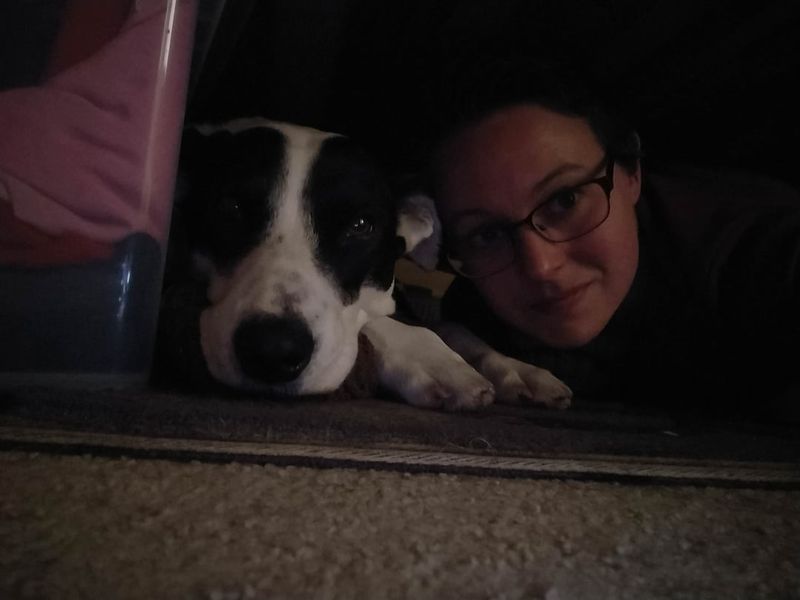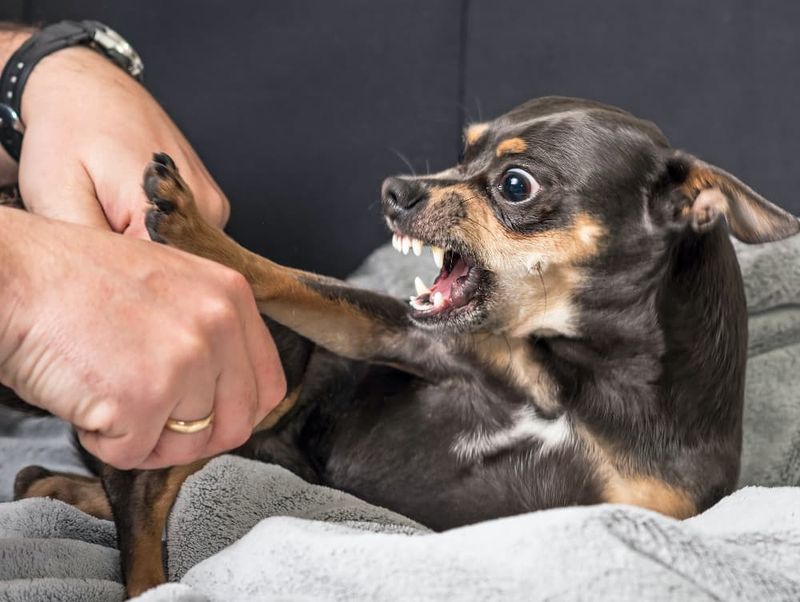Dogs communicate their emotions in subtle ways, and anxiety is no exception. Recognizing these hidden signs can help you provide better care and comfort to your furry friend. In this article, we explore 17 often overlooked indicators of anxiety in dogs, each revealing a unique story that deserves attention.
Excessive Licking
A seemingly content dog that suddenly starts licking its paws more than usual might be telling you something. While licking can be a normal grooming behavior, excessive licking is often an indicator of unease.
This behavior is frequently linked to anxiety, as it can be a self-soothing mechanism. If your dog is compulsively licking its paws, consider whether there have been recent changes in its environment.
Dogs, much like humans, can experience stress from disruptions in routine. Understanding this subtle cue can lead to a happier, healthier pet. Fun fact: Dogs have sweat glands in their paws!
Yawning
Yawning in dogs doesn’t always mean they’re ready for a nap. In fact, frequent yawning can be a sign of stress. When a dog feels anxious, it may yawn to calm itself.
This action is similar to humans taking a deep breath to relax. It’s important to observe the context; if your dog yawns during a thunderstorm or when meeting new people, it might be feeling uneasy.
Recognizing this subtle sign helps in addressing the underlying anxiety. Interestingly, dogs often yawn when they see humans yawn – a sign of empathy!
Tail Tucking
Tail tucking is a classic sign of fear or anxiety in dogs. If a normally confident dog suddenly tucks its tail, something might be amiss in its world.
This posture can indicate that a dog is feeling threatened or stressed by its environment. Pay attention to other body language cues like ears pinned back or a lowered body posture.
A tucked tail demands a gentle approach to assess the source of stress. Fun fact: Dogs communicate with their tails, and tail positions can convey a wide range of emotions.
Panting Excessively
Panting is normal for dogs, but excessive panting without physical activity or heat can signal anxiety. It might be your pet’s way of coping with stress.
Consider the surroundings: a new environment, loud noises, or unfamiliar guests can unsettle your dog, leading to this behavior. Panting helps dogs regulate their temperature, but when linked to stress, it becomes a clear sign of discomfort.
Monitoring this behavior can guide you in creating a calmer environment for your pet. Did you know? Dogs have fewer sweat glands than humans, relying more on panting to cool down.
Pacing
Pacing is another sign of canine anxiety that can easily go unnoticed. When a dog walks back and forth, it might be mimicking a human’s anxious pacing.
This behavior often occurs when a dog is faced with an uncertain situation, like waiting for a family member to return home. Pacing can be indicative of separation anxiety or discomfort.
By noticing this sign early, you can intervene with comforting strategies. Fun fact: Border collies, known for their intelligence, often pace when they’re mentally stimulated!
Drooling
While some dog breeds naturally drool more, excessive drooling can be a hidden sign of anxiety. When a dog is experiencing stress, its body can react in various ways, including increased salivation.
This can be particularly noticeable during vet visits or thunderstorms. Recognizing this subtle cue is important for addressing the underlying anxiety.
Not all drooling is anxiety-related, but in context, it can be a useful indicator. Interesting tidbit: Some dogs drool just from the excitement of seeing food!
Shedding
Shedding is a natural process for dogs, but excessive shedding can be a sign of stress. When dogs are anxious, their bodies may react by releasing more hair.
This can often be seen in situations like moving to a new home or meeting new pets. Monitoring shedding patterns alongside environmental changes can provide insight into your dog’s mental state.
Understanding this anxiety indicator is crucial for maintaining your dog’s well-being. Did you know? German Shepherds, known for their thick coats, can shed heavily twice a year.
Whining
Whining is a vocal expression that can signify many emotions, including anxiety. When a dog whines, it may be trying to communicate distress or a need for comfort.
This is often seen in situations where a dog feels isolated or unsure, like during thunderstorms or when meeting strangers. Listening to these cues can help you ease their anxiety through reassurance.
Fun fact: Beagles, known for their vocal nature, often use whining to communicate with their human companions.
Hiding
When a dog suddenly becomes reclusive, hiding from the family or other pets, it can be a sign of anxiety. This behavior often reflects fear or discomfort.
Dogs might retreat to a quiet, secure spot during stressful events such as fireworks or loud parties. It’s essential to provide them with a safe haven where they feel secure.
Recognizing this behavior allows you to address their anxiety more effectively. Did you know? Pugs, despite their playful nature, can be quite sensitive to their surroundings.
Barking Excessively
Excessive barking can signal anxiety, especially if your dog is usually quiet. This vocalization might be an attempt to communicate discomfort or alert you to perceived threats.
Dogs often bark when they feel uneasy about unfamiliar sounds or strangers. Understanding this behavior can help you identify and alleviate sources of stress.
Fun fact: Small dog breeds, like terriers, are known for their vocal tendencies, which can amplify when anxious.
Destructive Behavior
A dog that suddenly turns to chewing furniture or other destructive behaviors may be telling you it’s anxious. This can occur when a dog is left alone or experiences major changes at home.
Such behavior is not only a sign of boredom but also signifies stress. Addressing the root cause is vital for both the dog’s well-being and your home’s safety.
Interesting tidbit: Labradors, known for their playful nature, often chew to relieve teething discomfort or anxiety.
Change in Appetite
Anxiety can significantly impact a dog’s eating habits. A sudden loss of appetite or even overeating can indicate stress.
Changes in environment, routine, or household dynamics can lead to such dietary shifts. Monitoring your dog’s eating behavior can provide clues to their emotional state.
Addressing these issues early can prevent further health complications. Fun fact: Poodles, known for their intelligence, are highly sensitive to their surroundings, which can affect their appetite.
Aggression
A normally gentle dog that becomes aggressive might be responding to anxiety. Aggression can manifest due to fear or perceived threats in their environment.
This behavior is often noticed in situations where the dog feels trapped or overwhelmed. Understanding and managing this response can aid in maintaining harmony.
Did you know? Rottweilers, despite their intimidating appearance, are known for their loyalty and protective nature.
Shaking or Trembling
Shaking isn’t just a response to cold; it can also signal anxiety. A dog that trembles might be reacting to loud noises, people, or changes in environment.
This behavior is common in smaller breeds and can indicate that the dog needs reassurance and comfort. Recognizing this sign helps in providing the necessary support.
Fun fact: Chihuahuas, with their tiny stature, often shake due to high metabolism and excitement.
Loss of Interest in Play
A playful dog that suddenly loses interest in its favorite activities might be experiencing anxiety. This change can be due to stressors like new pets or family changes.
When dogs retreat from play, it can signal emotional discomfort, requiring attention to their mental health. Observing these shifts aids in maintaining your dog’s happiness.
Did you know? Boxers, despite their energetic nature, need mental stimulation to remain engaged.
Increased Need for Attention
A dog that suddenly becomes unusually clingy may be feeling anxious. This behavior often arises when a dog seeks reassurance from its owner.
Such attachment can be observed during changes in routine or environment. Providing extra affection and security can alleviate their stress.
Fun fact: Spaniels, known for their affectionate nature, often mirror their owners’ emotions closely.
Refusal to Obey Commands
When a dog that usually obeys commands suddenly becomes stubborn, it might be experiencing anxiety. Stress can disrupt a dog’s focus and willingness to follow instructions.
This disobedience can arise from confusion or fear, often requiring patience and understanding from the owner. Recognizing this sign helps in addressing the root cause.
Did you know? Bulldogs, with their tenacious spirit, often need positive reinforcement for effective training.

















